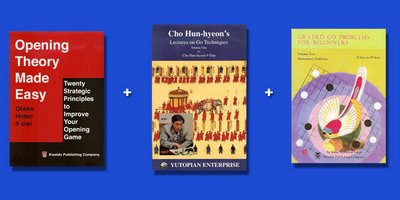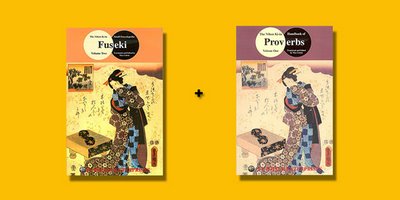Core Library Materials and Supplements
It's now been a year since I started taking this game seriously and I've learned quite a bit since June of 2005 when I started reading Janice Kim's Learn To Play Go, Vol.1 while my family was on vacation in Las Vegas.
I'm obviously the sort of Go player who learns from both books and actual play. I have collected quite a few over this year and I've decided to name the best of the best; the books that I would have wanted someone to have recommend to me a year ago.
I've divided the books into two categories and selected only those that are in-print.
- Core Library - These are the books that you should have at the appropriate level. For this post, they are highlighted with a blue background.
- Supplements - These are books that you don't need, but are very good and could infuse you with more ideas for faster development.
Serious Introductory Stage: Core Library
 If you want just a quick introduction to the game that will get you to, technically, about 35-kyu, then you just need to use the online site The Interactive Way To Go. To achieve about 28 to 26 kyu strength on KGS, these books are recommended.
If you want just a quick introduction to the game that will get you to, technically, about 35-kyu, then you just need to use the online site The Interactive Way To Go. To achieve about 28 to 26 kyu strength on KGS, these books are recommended.- Learn To Play Go, Vol. 1 (by Janice Kim) or Go for Beginners (by Kaoru Iwamoto) - The former is, in my humble opinion, the easiest and most convenient introductory book to start with (it also comes with cardstock boards and pieces) and may work best for some younger players. The latter is a more robust introductory book with more content.
- Graded Go Problems for Beginners, Vol.1
Serious Introductory Stage: Supplements

These are books that you might want to turn to for a few more ideas that could power-up your game. None of them perfectly address all the needs of advancing beginners, but all three are very good. Any would probably serve you well through your teen-kyus. If possible, try to browse all three to see which might best cover the areas you would like to improve upon.
- The Second Book of Go (by Richard Bozulich) - A people's choice book. It's very popular among beginners although some senior players feel that it touches too lightly upon its subjects. The book is meant to be seminal; not comprehensive.
- Basic Techniques of Go (by Isamu Haruyama and Yoshiaki Nagahara) - This is my preference because it reminds me of a textbook curriculum. I like its broader coverage of handicap Go. Some of its material may be a little difficult for beginners.
- The Fundamental Prinicples of Go (by Yilung Yang) - The most difficult of these three recommendations, it is still a good book which offers more coverage of invasions and reductions (used in the middle game) as well as fundamental strategies.
Beginner Stage: Core Library

These books are good to get at about 26 kyu on KGS but the first two will probably serve you well until you have become a single-digit kyu.
- Opening Theory Made Easy (by Otake Hideo) - I have yet to hear one Go player say anything to suggest that this book is non-essential. It provides key ideas that will power-up your opening and lay the strategic foundation for more successful matches.
- Cho Hun-Hyeon's Lectures on Go Techniques, Vol.1 (by Cho Hun-Hyeon) - In addition to strategy, one must develop tactical skill. This is a book that you will want to turn to after you have lost a few games because of inefficient moves. While it may seem a little dry at the start, it is actually very good material for showing the why's behind efficient moves, good shape, and elementary joseki.
- Graded Go Problems for Beginners, Vol.2
Beginner Stage: Supplements

I very much enjoy these two books and I get a lot of ideas out of them. At this stage, both are at the borderline pf being core library materials.
- Proverbs: The Nihon Ki-in Small Encyclopedia Series, Vol.1 - This book is great for down-time reading that can still improve your game.
- Fuseki: The Nihon Ki-in Small Encyclopedia Series, Vol.2 - Explains the strategies behind the popular openings and gives a basic introduction as to how they should be played - and how they should be countered.
Intermediate Starter: Core Library

For many Go players, these are the holy trinity of intermediate Go books. DrStraw (AGA 5D) considers them to be absolutely essential and the ones he would recommend if he were limited to only three books. There are those who attest that these will truly lay the foundation for achieving shodan.
Make no mistake, the material in these will be difficult even in one's teen-kyus and you will not absorb everything quickly. They are meant to be read and re-read to get their full benefits.
- Tesuji (by James Davies)
- Life And Death (by James Davies)
- Lessons in The Fundamentals of Go (by Toshiro Kageyama)
More information relating to book selections can be found on GoDiscussion.com's Books section and its Go Product Database.
Fuseki Quiz 8/20
Scoring of Last Weekend's Fuseki Quiz 7/20
- A = 6
- B = 4
- C = 10, Because the black positions on the lower right and left are strong, the invasion at Black 1 is just the move. If White jumps to L5, Black keeps up the pressure by jumping to J5. If Black fails to make this invasion, White will play H4.
- D = 2
- E = 8






5 Comments:
Quick suggestion: Maybe when you give last week's solutions, you can provide a link to last week's problem. :-)
Oh Yes. I would very much like the problem and the solution to be available ot the same time. The way it is now, I always see the solution and then its too late to go find the problem and think about it because I already know the solution.
Problem:
I can't decide if I like B or D better.
D - This move really firms up the right side, and leaves black with good opportunities to come out into the middle. I think D is probably white's favorite move, so maybe take it for that reason.
B - this move starts to grow a big moyo. I would expect white to have to reinforce it's lower right side in response (though maybe not immediately). I would expect this to let you move to the center from B claiming lots of territory, tho maybe not, this might be B's weakness. White might get the D point, but I think black can retain life and possibilities for expansion for his right side stones.
Books:
I've been reading through the Davies 'Elementary Go Series'. I'm not reading them in order. I read 'In the Beginning' and 'Tesuji' first and I liked them a whole lot, but I haven't been as satisfied with '38 Basic Joseki' 'Attack and Defense' or 'The Endgame'. I haven't read 'Life and Death' yet. What are people's opinions of this series as a whole? Should it be read together as a series, or should people just cherry pick the best titles (which are they?) and move on to a different author? And is the Otake Hideo opening theory book way superior to the Davis one (In the Beginning)?
Also - I liked 'Tesuji' a lot, and got stronger for having read it. But that isn't to say that I can spot an application for each of the neat tricks it shows in my own games. I have thought of trying to make flashcards of the material in the book. What (free!) tool would anyone reccomend for this type of thing? I found many that didn't seem quite right. Does this even sound like a worthwhile study effort?
Oh, and finally, I have a friend who is in Seoul teaching ESL. I've let her know that I would happily re-imburse her for a quality goban, but she doesn't really know anything about go. I've seen plenty of companies that import from Korea, but does anyone know of a physical location to which I may direct my friend in S. Korea - preferrably around Seoul?
Looks like I had a lot to say today! I hope someone has some thoughts for me!
Thanks for the formatting suggestions, everyone!
I've already set up my blog so I post a quiz on a weekend and its solution on the following weekend so I'll stick with that. I will, however, provide a link-back to the previous week's problem in the solution.
Regarding 38 Basic Joseki and selecting books in a series
This book is alright but I wouldn't consider it to be the best way to introduce oneself to joseki or to study it. In fact, one of the better ways to study joseki is with Cho Hun-Hyeon's Lectures on Go Techniques which I had recommended in my post. This is not, in itself, a joseki book but, because he illustrates to the reader the optimal moves/tactics in situations (and why variations fail), he is in effect teaching joseki and he states so towards the end.
Now, if you're really serious about studying joseki, then you should get Ishida's joseki dictionary. The trouble with that is, at US$20 each, you'll be shelling out US$60 for the whole set. These three books are, however, the best and easiest-to-use references that I've seen to date on joseki. With Ishida's in-depth explanations and branch examinations, you'll understand why the moves are optimal and you'll truly be studying joseki - not memorizing them.
After one year of playing this game and collecting a few books, I would say that you don't really need to stick with a series; you can cherry-pick the best ones and mix them with other great books.
That's the whole purpose behind my list in this post; to help the cash-strapped Go player get the most bang for his/her buck when choosing books to augment studies and play.
Comment on C refers to B in the diagram.
(Tommie on GD)
Post a Comment
<< Home